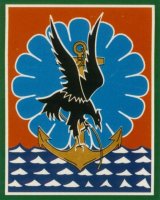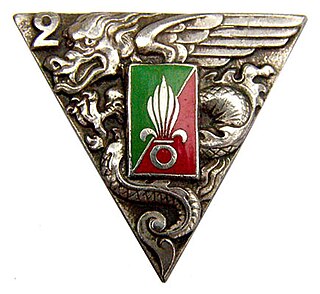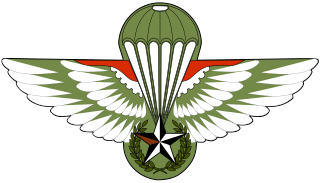
A paratrooper is a military parachutist—someone trained to parachute into a military operation, and usually functioning as part of an airborne forces. Military parachutists (troops) and parachutes were first used on a large scale during World War II for troop distribution and transportation. Paratroopers are often used in surprise attacks, to seize strategic objectives such as airfields or bridges.

The French Air and Space Force (AAE) is the air and space force of the French Armed Forces. Formed in 1909 as the Service Aéronautique, a service arm of the French Army, it became an independent military branch in 1934 as the French Air Force. On 10 September 2020, it assumed its current name, the French Air and Space Force, to reflect an "evolution of its mission" into the area of outer space.

A parachutist badge is a military badge awarded by the armed forces of many states to soldiers who have received parachute training and completed the required number of jumps. It is difficult to assess which country was the first to introduce such an award.

The 2nd Foreign Parachute Regiment is the only airborne regiment of the Foreign Legion in the French Army. It is one of the four infantry regiments of the 11th Parachute Brigade and part of the spearhead of the French rapid reaction force.

The 1er Régiment de Parachutistes d'Infanterie de Marine or 1er RPIMa is a unit of the French Army Special Forces Command, therefore part of the Special Operations Command.

The 11th Parachute Brigade is a unit of the French Army, predominantly infantry, part of the French Airborne Units and specialized in air combat and air assault. The brigade's primary vocation is to project in emergency in order to contribute a first response to a situational crisis. An elite unit of the French Army, the brigade is commanded by a général de brigade with headquarters in Balma near Toulouse. The brigade's soldiers and airborne Marines wear the red beret (amaranth) except for the Legionnaires of the 2ème REP who wear the green beret.

The 6th Marine Infantry Parachute Regiment is an airborne infantry unit of the French Army.

The 3rd Armoured Division is a unit of the French Army. The Division is the heir of the 3rd Algerian Infantry Division formed in 1943 and dissolved in 1946, which contributed in the liberation of Marseille during the Second World War.
The Action Division, commonly known by its predecessor's title Action Service is a division of France's Directorate-General for External Security (DGSE) responsible for planning and performing clandestine and covert operations including black operations. The core specialisations of the Action Division are sabotage, destruction of materiel, assassination, detaining/kidnapping, interrogation with and without using torture, infiltration/exfiltration of persons into/from hostile territory and hostage rescue.
The units and formations of the French Army which fought in the Algerian War changed over time.

The 25th Parachute Division was an airborne division of the French Army, part of the French Airborne Units. Consisting mainly of air infantry specialized in airborne combat, air assault and established in 1956; the Parachute Division took principal part only in the Algerian War.

The 2nd Foreign Parachute Battalion was a parachute battalion of the Foreign Legion in the French Army initially composed of volunteers of the 4th Demi-Brigade of the Foreign Legion.

The 3rd Parachute Chasseur Regiment or 3e RCP was a French unit of Second World War known in the British Army as the 3rd SAS Regiment and originally named the 3rd Air Infantry Battalion. Involved in the operations of the Liberation of France and The Netherlands, the unit was temporarily dissolved at the end of the conflict and was reorganized between 1979 and 1998.

The 2nd Parachute Chasseur Regiment or 2e RCP, is one of the most decorated French units of the Second World War, the only land unit awarded the red fourragère in that war, including six citations at the orders of the armed forces. The French Navy 1500-ton class submarine Casabianca also accumulated six citations at the orders of the armed forces and therefore its crewmen were entitled to wear the same fourragère.

The 25th Airborne Division was an airborne unit of the French Army. Constituted at the end of 1945, the division was created on February 1, 1946 and was dissolved during the Indochina War in June 1948; it did not serve in Indochina as an entire division.
Colonel Frédéric Cyrille Jules (Fred) Geille was a French military officer. Frédéric was the 1st French paratrooper and a Fighter pilot of the French Air Force as well as a commander and founder of various units and initiatives. He is also considered as the Father of French paratroopers and the inventor of French High-Altitude Operational Jumpers.

The Algerian People's National Armed Forces (ANP) has several special forces regiments as well as several specialized regiments.















